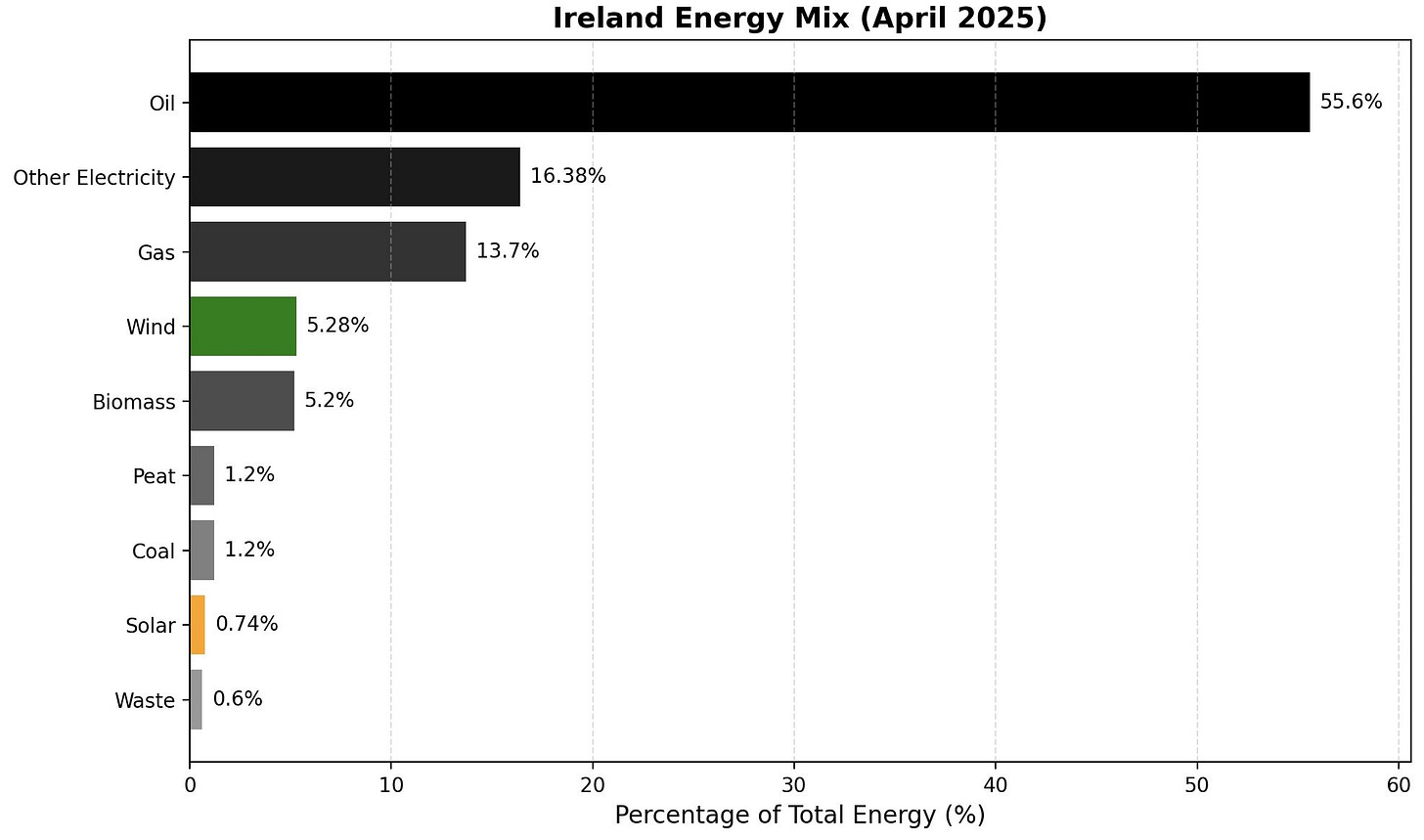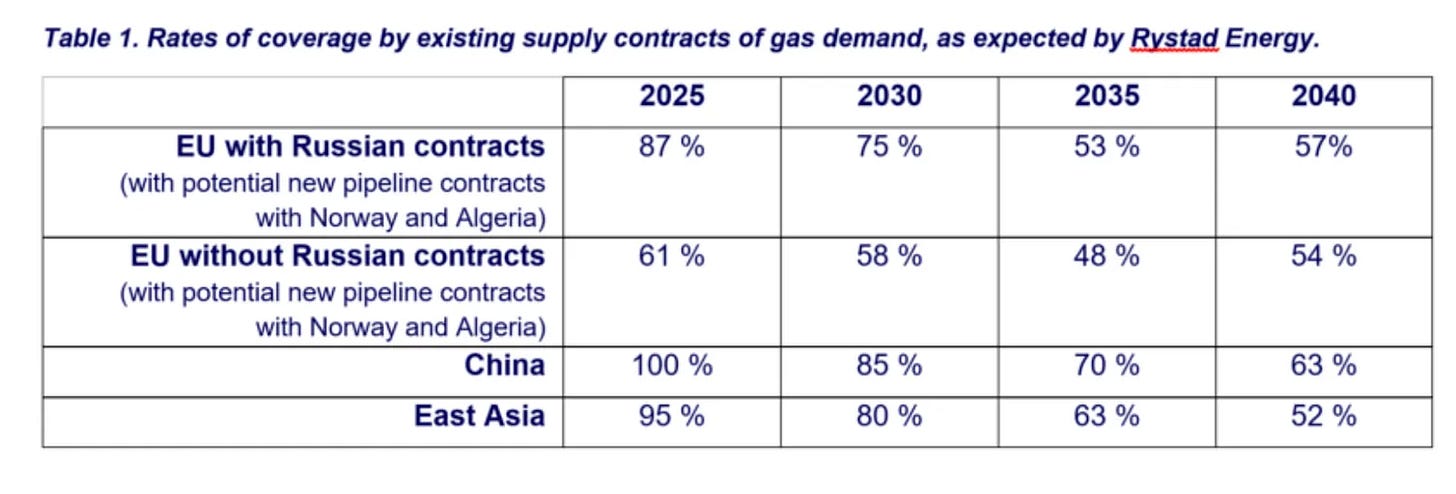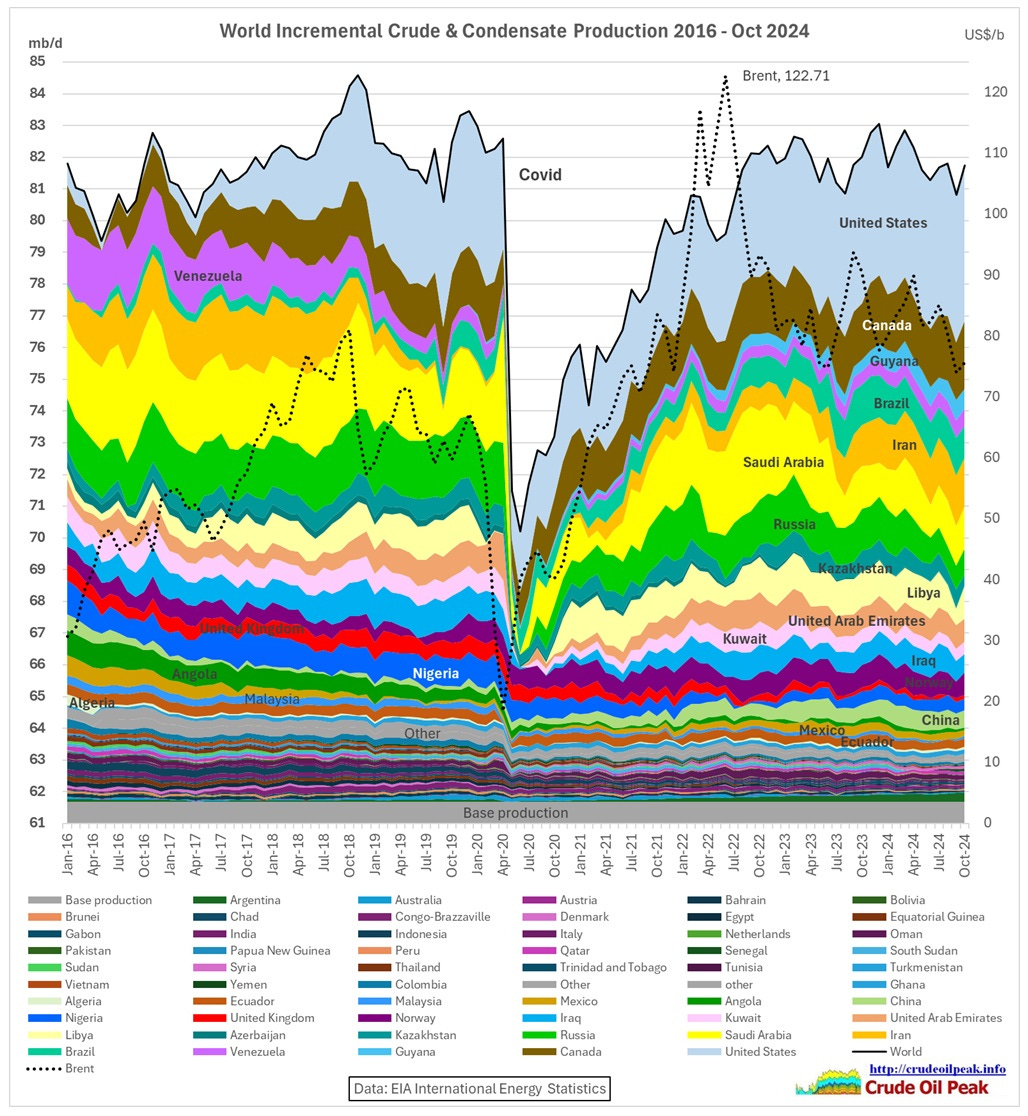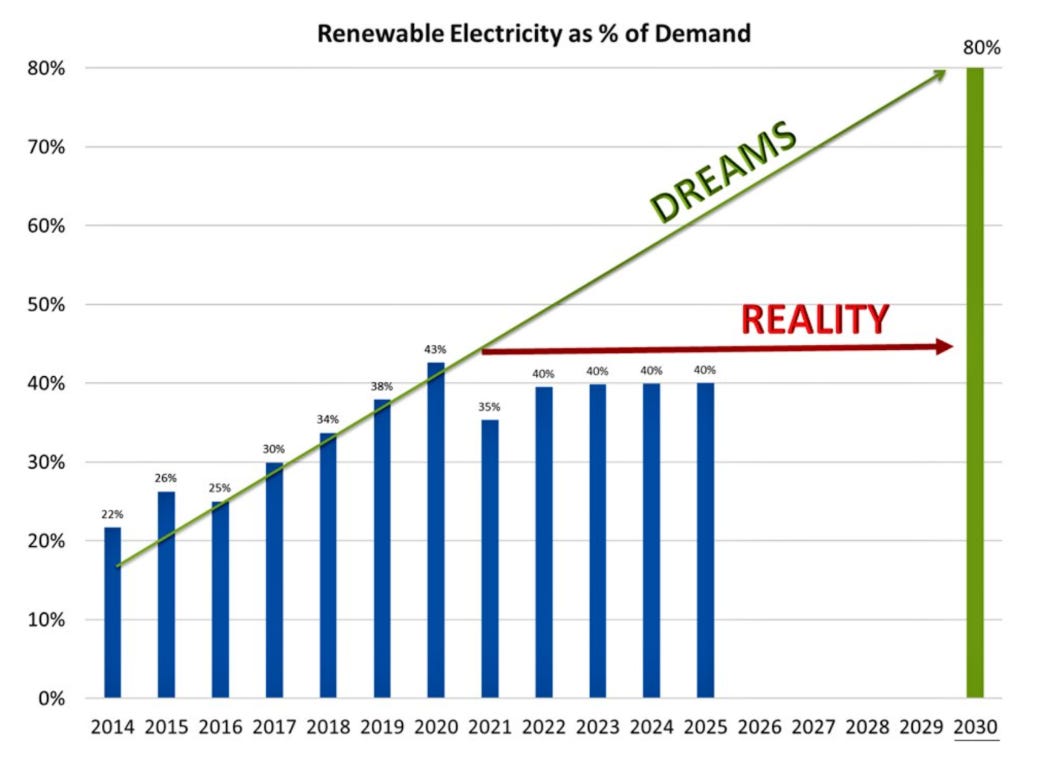Ireland's Energy Transition Looks Dead In The Water
After 30 years of energy transition, in April 2025, wind and solar provided just 6% of Ireland’s energy
There’s a curious tunnel-vision focus on Ireland’s electricity grid when it comes to energy transition. Decarbonise the grid, its inferred, and its mission accomplished. But Ireland’s electricity grid is only 22.4% of the country’s energy use. The other 87.6% - mostly oil for transport and gas for heating - tends to get left out of the conversation.
A fairer assessment of Irelands energy transition journey to date would look at Ireland’s entire energy system.
I did that for April 2025. That month, wind provided 23.37% of Ireland’s electricity, with solar contributing 3.29%. Since electricity is just 22.4% of Ireland’s energy, that means, after 30 years of energy transition, in April 2025, wind & solar contributed 6.02% of Ireland energy needs.
Considering we’ve been at this a long time, I decided to undertake a full review of energy transition in Ireland from first principles: what energy does for us, why a transition is compulsory, and where we go from here.
What Is Energy
Whether it’s our muscles fuelled by food, or machines fuelled by diesel, energy is what moves atoms and makes things happen. The first law of thermodynamics states that energy cannot be created or destroyed, it can only be transformed from one type to another e.g chemical energy to mechanical energy in a car.
Electricity is a subset of energy and is a way to physically move energy from where it is harnessed to where it is used. When you use electricity in Ireland, fossil gas is being burned somewhere - along with some help from wind turbines - and that energy travels through the grid to your home, where it powers motors, lights, heaters, and computers. When you hear someone say a technology will be invented to create energy, they are immediately falling foul of the first law.
EROI
The most important method of evaluating an energy source is determining its EROI, which stands for Energy Return On Energy Invested. When we harness energy, we need to spend some energy in order to do so. It is crucial that what we get back is greater than what we spent.
To extract oil, a well needs to be drilled, pumps need to be run, and processing facilities need to be powered.
When we access energy we tend to access the easy-to-get energy first. When the first oil wells were drilled, the EROI was 100:1 meaning one barrel of oil was needed to extract 100 barrels. Now, with shale oil, the ratio can be as low as 4:1, meaning 25% of the oil extracted needs to be put back into getting more oil.
EROI applies to all energy sources. The energy for manufacturing wind turbines and solar panels - which comes from oil, coal and gas - means those sources have an EROI of 12:1 and 5:1 respectively.
In order for an energy source to be of use, it must have an EROI of at least 2:1. The man who popularised EROI, Charles Hall, determined that value by looking at the period from the 1300s to 1700s in Britain. At that time, 50% of people were involved in energy production, such as growing food and harvesting firewood. That was what was required to support themselves, and the other half, giving a minimum EROI of 2:1.
Biofuels struggle to achieve an EROI above 2:1 - all that energy required for cultivating and processing the crops for biodiesel and bioethanol adds up, and the return is often below 2. This is hidden currently by the subsidy oil provides to the production of biofuels. Large scale Anaerobic Digesters suffer from the same problem. When oil goes, both technologies will likely go with it.
What Is Oil?
As solar energy hit earth, it was absorbed by plants. Animals ate those plants. Over millions of years and where geological conditions were just right, the remains of those animals were compressed into extremely dense energy in the form of oil and gas.
This means every time we drive a petrol car or heat our home with gas, we’re burning millions of years of condensed solar energy that fell to Earth long before dinosaurs even existed. The Industrial Revolution of the last 200 years was built on burning up the remains of ancient life.
Earth acted like a giant battery and the battery trickled-charged slowly over millions of years.
In the 1800s, we began to discharge that planetary battery at a much faster rate than it charged. We don’t know exactly how much is left, but we do know the easy-to-reach, high-EROI oil is largely gone.
Switching from the highly concentrated solar energy stored in fossil fuels to the diffuse solar energy we capture today with wind turbines and solar panels is like blowing through a massive family inheritance in five years of hedonism, only to find yourself trying to get by on a modest paycheck. One was a windfall built over millions of years; the other is a steady but modest income you earn in real time.
Over the past 200 years as the battery discharged, the human enterprise was supercharged, with world population going from 1 billion to over 8 billion. Today, 81% of the energy we use comes from oil, gas, and coal. One barrel of oil contains the equivalent of 5 and a 1/2 years of human labour. The 5 billion-strong human labour force is silently supported by 500 billion human-equivalent workers in the form of oil, coal and gas.
As of 2023, wind contributed 3.2% of primary energy, with solar contributing 2.3%. This has large implications: since after multi-trillion dollar investment, wind and solar are still less than 6% of primary energy, it is highly likely we are heading to a lower energy future as the bulk of energy sources, those from fossil fuels, are phased out. That has consequences for grid interconnection - if we are in a lower energy future, it is likely there will be less energy available for countries to import.
Liquid Fuels
The global economy that has risen to fuel our lifestyles is founded entirely on liquid fuels, namely diesel and petrol. Raw materials are extracted from the environment using diesel. After smelting and moulding (usually with coal), the materials are transported to their assembly point using diesel. The final product is shipped and trucked to the store using diesel. The agriculture needed to feed the drivers uses diesel!
Diesel and petrol changed transportation because they pack a huge amount of energy into a small area. This high energy density means there is enough power not just to move the vehicle, but also to carry the fuels weight. Before oil, coal was the main energy source. Coal has a lower energy density - it can power a train because of the low friction on rails, but it doesn’t contain enough energy to carry its own weight in a car, where friction is higher.
This oil that powers the global economy is free, provided to us by Mother Earth over hundreds of millions of years. You need to pay people to extract it, but oil itself is free. As a general rule, any fuel that needs to be manufactured - hydrogen for hydrogen fuel cells, biofuels, synthetic fuels - will have a hard time competing with something that is free.
The best candidate so far to replace oil in transport is the lithium ion battery. But these are 27 times less energy dense than diesel. The further you’re going and the bigger the load, the less useful batteries are. The implication is that to replace diesel, we will likely have to harness energy at a stationary power plant - either renewables or nuclear - and move it via electricity to the vehicle that we want to move. Or in other words, we will need lots and lots of electric rail.
Vaclav Smil’s Four Pillars Of Industrial Civilisation
While liquid fuels are the lifeblood of the global economy running, the Four Pillars of Industrial Civilization - steel, concrete, fertilizer, and plastic - are its backbone.
None of these materials can be produced at anything close to the current scale without fossil fuels. Figuring out how to maintain a functioning society as these foundational materials become scarcer - or harder to produce - should be central to any serious energy transition plan.
It is noteworthy that Ireland’s official plan depends heavily on large wind turbines that will need to be replaced every 20 years. Wind turbines require extensive volumes of three of the four pillars - cement, steel and plastic.
Depletion
Currently, the EU is importing 97% of its oil and 90% of its gas. An oil report from 2021 commissioned by the French Defense Ministry found that 14 of the 16 biggest suppliers to the EU have passed peak oil production and are extracting less each year. The authors - two former Total execs and an International Energy Agency oil expert - also found:
the overall depletion rate of total cumulative oil field discoveries to date for the 16 countries is close to 70%
a decline of approximately 12% by 2030 is expected, as compared to its 2019 level
a 50% drop in oil availability to the EU by 2050 is projected
So by 2050, the authors project, the EU will have about half the oil available to it as it does today.
In a natural gas report by the same group, it was estimated only 53% of the gas the EU will need in 2035 is accounted for - even WITH the resumption of Russian gas.
The reduction in the availability of oil and gas can already be seen - world crude oil production (from which the most important fuel is derived - diesel) peaked in November 2018 and has not recovered.
If climate change is not a motivator for the energy transition, surely this is.
Climate Change
Speaking of climate change, it has proved to be an insufficient motivator for change - why would a politician forgo the elixir of fossil-fuel-powered economic growth, knowing their political rival will not?
While its quite easy to pay lip service to climate change and insist its being taken very seriously indeed, there is an obvious elephant in the room - the IPCC projects that as the AMOC weakens, it will leave Ireland on a hot-air/cold-air fault-line (I covered this in more detail here). Since storms are caused by the difference in temperature of adjacent air masses - the greater the difference the more violent the storm - the west coast of Ireland will likely see increasingly severe storms, eventually becoming home to the worlds largest superstorms. The foundation of our energy transition plan places wind turbines directly in the path of climate change. Is this really a good idea? The 23 metre waves that halted another offshore wind project off the coast of Connemara will look like a gentle swell.

Land Competition
Fossil fuel energy, which provides 82.7% of Ireland’s energy, is sourced from under the ground. As we reduce fossil fuel usage (either because the environmental damage becomes overwhelming, or because they’re no longer available), more and more energy will be sourced from above ground, creating conflict and competition.
Biofuels compete with land use for food production, while wind turbines and solar panels and their supporting infrastructure are subject to constant objections, and are increasingly delayed by planning issues.
The implication is that if we are to source our energy from above ground, the energy system should have a small material footprint, and therefore have high energy density. If we are to keep sourcing energy from below the ground, it must be renewable and zero-carbon. A third option is we do neither, and instead scale back energy use, likely in an unplanned way.
Energy Density
An important aspect of energy is its density i.e. the amount of energy contained per unit of mass. Traditionally, we have accessed increasingly more dense forms of energy. Coal is more dense than wood. Oil is more dense than coal. Natural gas is more dense than oil. And uranium is the most dense of all.
Wind and solar are not fuels, but instead capture diffuse solar energy. Because solar energy is so diffuse, wind and solar collectors must cover vast areas of land.
Uranium is by far the most energy dense of fuels - 70,000 times more dense than natural gas per unit of mass - but is still bottlenecked by the 19th century steam turbine technology we use to harness it’s power.
What A Real Energy Transition Plan Looks Like
Since energy is required for everything, changing the energy system means fundamentally rethinking our entire system. One of the most complete systems-wide plans comes from France: Le Plan de transformation de l'économie française (The French economy transformation plan) by The Shift Project. I covered it in more detail here.
The authors outline a plan for decreasing carbon emissions by 5% each year, in line with the Paris Agreement. The plan prioritises human well-being while outlining the drastic changes needed in society to phase out fossil fuels. Throughout the execution of the plan, people must have access to healthy food, work, transport, and genuinely useful tools and equipment.
Here are some of the most important cornerstones of that plan:
Transport: Nearly all goods today are moved by diesel-powered trucks. Under the plan, this shifts to electric rail. For personal travel, EVs are to replace internal combustion engine (ICE) cars - but EVs require four times more metals than ICEs. With material throughput in the economy slowing as liquid fuels leave us, a one-to-one replacement is unlikely. Carpooling will become widespread, while electric bicycles will become more common.
Food production: Food must become increasingly local. Currently, it takes 10 fossil fuel calories to produce 1 calorie of food. A reduction in fossil fuels will mean it will no longer be possible to cultivate crops thousands of miles away, feed them to animals another few thousand miles away, and move them to a supermarket another few thousand miles away. Farms will look much more likely they did in the past and will move away from specialisation and back to mixed enterprises. As fossil gas becomes less available, nitrogen fertiliser - which relies on fossil gas as a key input - will also become scarcer. Regenerative agriculture techniques must be embraced to offset the reduction in the availability of chemical fertilisers.
Societal buy-in: The energy transition will put extreme strain on societies. High-trust and societal buy-in will be needed. Mandatory employee training in energy and climate should be rolled out across all businesses.
Energy: There will be a 50% reduction in final energy use by 2050 due to the constraints outlined., with nuclear power providing the bulk of the electricity in France by 2050.
So How Is Ireland Doing?
Transport: Ireland has the lowest share of electrified rail in Europe, with just 5% of its network electrified. By contrast, Finland - a country with a similar population - has electrified 95% of its rail system.
Food production: Ireland is currently importing 83% of its food, and is heavily dependent on chemical fertilisers.
Societal buy-in: Most people remain unaware of the true scale of the challenge.
Energy: In April 2025, wind & solar contributed 6.02% of Ireland energy needs.
Safe to say, we’re not doing so good.
The Problem With Our Existing Plan
Of the various forms of renewable energy, hydro and geothermal as always-on sources are the most useful. Solar comes next with arguably wind in last place. This is because solar and wind need to be buffered when the wind isn’t blowing and the sun isn’t shining. This is easier with solar since solar energy follows a predictable pattern with the rising and falling of the sun, unlike wind when there can be multiple days of no action.
Integrating renewables is problematic. The grid - sometimes called the world’s biggest machine - can be pictured as being like a superhighway. All the traffic must be going the same speed. If a new car joins, it has to match the speed of the traffic. Otherwise, there’s chaos. This is called grid frequency and in Europe it’s 50 hertz per second.
This steady rhythm is maintained by big spinning turbines from hydro, gas, coal, deep geothermal or nuclear. Renewables can be added to the mix, but they are passengers, not drivers. Renewables can add power only if the grid is already stable. They cannot create or hold the grid steady on their own. The more renewables on the grid, the less there is of what physicists call “inertia”, and the greater the instability. It was this lack of inertia which brought down the grid in Spain and Portugal recently.
As we are phasing out coal and gas, this inertia must come from zero-carbon firm power sources, and those are nuclear, deep geothermal or large-scale hydro.
Zero-Carbon Firm Power
Many countries in Europe have nuclear, geothermal or hydro, and some have all three. Only Ireland, Denmark, Germany, Poland and the Netherlands lack all of the above. Poland and the Netherlands have announced plans to build nuclear power plants. Denmark is now set to lift its ban on nuclear energy, while Germany is also reconsidering its anti-nuclear stance. Ireland now looks set to be out on its own as the only country that will attempt to build a grid with no zero-carbon firm power.

Long Duration Energy Storage (LDES)
With a renewables dominated grid and no firm power, the argument is that LDES will come to the rescue. But all have problems:
Batteries: Batteries are best suited to stabilizing the grid over short periods. They become much too costly as an option for LDES. For example, if Ireland was to electrify everything, it would need 90TWH per year (see my calculator https://wind-and-solar.vercel.app). To store this would require 443,590 Tesla Megapack 2 XL at a cost of €887 billion.
Pumped Hydro: Ireland has one pumped hydro station - Turlough Hill in County Wicklow. We would need to build 958 Turlough Hills to store our electricity needs for 7 days.
Hydrogen: As the smallest molecule, hydrogen faces two major challenges: it is difficult to store and transport. Its round-trip efficiency as an LDES solution is around 25%, meaning that for every joule of energy you want to retrieve, you need to input about four joules.
Reality Bites
While the Irish government are responding to the increasingly obvious problems by announcing ever higher offshore wind targets, actual wind contributions to the grid have levelled out. Wind and solar have a maximum limit of 75% of grid contribution set in order to keep the grid stable. In recent years, it looks like we’ve already hit the maximum wind on the grid already.
What Now For Ireland?
After 30 years of transitioning away from fossil fuels, Ireland still experiences days when wind and solar supply less than 3% of our energy. At the same time, major wind projects are collapsing amid growing opposition from local communities, environmental groups, and planning challenges. It is safe to say, at this stage, Plan B, C and D are needed.
What should the cornerstone of alternative plans be? As shown above, the ideal above-ground energy system should have a small material footprint, and be highly energy dense. Nuclear energy fits that description. If we are to continue to source our energy from below the ground, it should be zero carbon and renewable. In other words, deep geothermal.
Option 1: Nuclear:
Uranium contains 70,000 times more energy by unit of mass than fossil gas. Its material footprint is much smaller than wind and solar. While uranium is non-renewable, because of its energy density, we only need a fraction of the amount that we do of fossil gas.
I covered the cost of nuclear versus offshore wind previously and showed nuclear would be comfortably cheaper than offshore wind when costed over a century.
Nuclear is sometimes presented as a silver bullet. But it needs to be accompanied with systems-wide planning, with increased emphasis on electric rail, as liquid fuels become a thing of the past. However, nuclear energy is currently banned in Ireland, and currently has little political support.
Option 2: Deep Geothermal
There’s another method of harnessing nuclear power, and that is via deep geothermal. Harnessing geothermal energy involves drilling deep boreholes up to 10 km deep, passing water through the holes where it is heated and converted to steam by decaying uranium, thorium, potassium and other elements in the Earth's crust, and directed to turn a turbine, generating stable always-on baseload electricity.
Temperatures of at least 150°C are required for generating electricity. On average, Earth's continental crust warms about 25–30 °C per kilometer of depth. Boreholes of up to 6 km have been achieved in Finland, deep enough and hot enough to generate electricity. Ireland has good low to medium geothermal resources but very deep boreholes in multiple locations will likely be required to generate baseload power for Ireland's grid. This is right on the edge of what is technically achievable.
Given deep geothermal may be the only politically acceptable source of baseload power, it should be thoroughly explored.
Wildcard 1: Solar Microgrids
While solar energy is not dense, and is materially intensive, by harnessing the energy close to where it is consumed, it is much less materially intensive than offshore wind. Solar panels could be placed in densely populated areas over any place where there isn’t nature - this means over parking lots, roads, and on buildings. Transport could shift to solar powered podcar systems, with long distance transport replaced by solar-powered container-carrying monorails. With microgrids replacing one centralised nationwide grid, inertia becomes less of a problem. This would be a very different world to what we are used to, with society needing to adjust to regular periods of intermittent electricity.
Wildcard 2: Interconnection to Iceland
Interconnection is often used as a get-out clause of 100% renewable plans. However, it is highly likely that the coming decades will see energy availability decrease as fossil fuels phase out, and therefore there will be less energy available for import. One country unlikely to face this problem is Iceland. Iceland has vast, renewable energy potential in its geothermal resources. Interconnection to Iceland in the face of all the energy challenges the European continent is likely to face would make more sense.
Conclusion
The energy transition is not unfolding as hoped. The focus has been on replacing fossil fuel KWH in our existing grid with renewable energy KWH. This is woefully inadequate, and ignores the complete rethink that is needed of how society is structured. We remain focused on a solution - offshore wind - that was seemingly picked long before the enormity of the problem was understood. This focus remains, even as it becomes increasingly obvious that the official plan almost certainly will not work. Above all, the public remains unaware of these severe challenges, and unprepared for them. It’s time to get back to the drawing board.












I love the line about how oil is needed for our baseline calculations paragraph 18 and also the need to view many climate policies such as public transport through a health lens